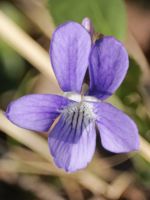Mon-Fri 9am - 5pm Mountain time
Nodding Onion vs Early Blue Violet
Allium cernuum
Viola adunca
NOT AVAILABLE THIS SEASON - MIGHT RETURN
NOT AVAILABLE THIS SEASON - MIGHT RETURN
Nodding Onion is a native perennial wildflower known for its nodding clusters of flowers that range in color from white to pink to purple. The lightly scented blooms provide pollen and nectar for pollinators, especially bees, which can collect while hanging upside down, a capability most other insects lack.
The narrow, grass-like leaves of the Nodding Onion can be used as a seasoning in cooked dishes, though bulbs and raw leaves should not be eaten in large quantities. All parts of the plant have an onion-like aroma when bruised, which helps deter deer and rabbits. They can self-seed readily, so removing spent blooms helps manage their spread. Tolerant of a range of soils, including alkaline, it is well-suited for a variety of plantings, including pollinator gardens and naturalization projects.
Early Blue Violet is a low-growing native perennial wildflower valued for its striking early-spring blooms. The flowers range in color from vibrant blue to deep violet, often marked with pale highlights and fine white hairs. They provide an important early nectar source for pollinators and serve as a host plant for several fritillary butterfly species.
It spreads by both seed and rhizomes, gradually forming small colonies. Its dark green, heart-shaped leaves add ornamental appeal, and the plant shows some resistance to deer browsing. Early Blue Violet is well-suited to naturalization projects and pollinator-friendly gardens, and has also been used in coastal butterfly habitat restoration in the Pacific Northwest.
Nodding Onion Quick Facts
Early Blue Violet Quick Facts
Toxicity: raw leaves and bulbs can be midly toxic
Toxicity: rhizomes, fruit, seed poisonous to humans

